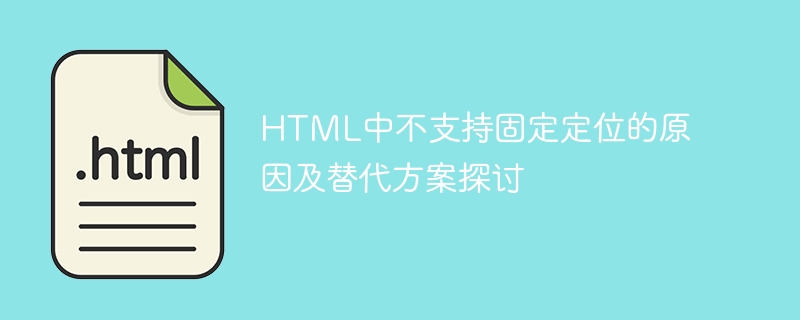

Discussion on the reasons why fixed positioning is not supported in HTML and alternatives
Introduction: In web development, we often encounter situations where fixed positioning elements are required. You can Keep elements in a certain position when scrolling to enhance user experience. However, in HTML, there is no direct support for fixed positioning. This article will explore why fixed positioning is not supported in HTML, as well as alternatives, and provide specific code examples.
1. The reason why fixed positioning is not supported in HTML
In the standard specification of HTML, there are no attributes or tags that directly support fixed positioning. This is mainly based on the following reasons:
2. Discussion of alternatives
Although fixed positioning is not directly supported in HTML, we can use some alternatives to achieve similar effects. The following are several common alternatives:
<!DOCTYPE html>
<html>
<head>
<style>
#fixed-element {
position: fixed;
top: 0;
right: 0;
}
</style>
</head>
<body>
<div id="fixed-element">这是一个固定定位的元素</div>
</body>
</html><!DOCTYPE html>
<html>
<head>
<style>
#fixed-element {
position: absolute;
top: 0;
right: 0;
}
</style>
<script>
window.onscroll = function() {
var element = document.getElementById("fixed-element");
if (window.scrollY > 100) {
element.style.position = "fixed";
} else {
element.style.position = "absolute";
}
};
</script>
</head>
<body>
<div id="fixed-element">这是一个固定定位的元素</div>
</body>
</html><!DOCTYPE html>
<html>
<head>
<style>
#fixed-element {
position: sticky;
top: 0;
}
</style>
</head>
<body>
<div id="fixed-element">这是一个固定定位的元素</div>
</body>
</html>Through the above alternatives, we can achieve the effect of fixed positioning in HTML and enhance the interactivity and user experience of the web page.
Conclusion: Although fixed positioning is not directly supported in HTML, we can use alternatives such as the position attribute of CSS, JavaScript, and the sticky attribute of CSS to achieve similar effects. When choosing an alternative, there are trade-offs based on specific needs and project compatibility requirements. I hope this article will help you understand the reasons why fixed positioning is not supported in HTML and the alternatives.
The above is the detailed content of Discuss the reasons why fixed positioning is not supported in HTML and alternatives. For more information, please follow other related articles on the PHP Chinese website!